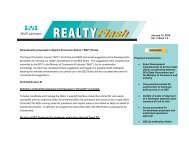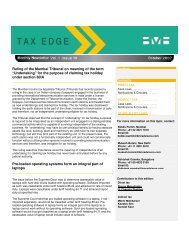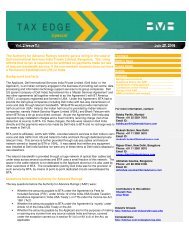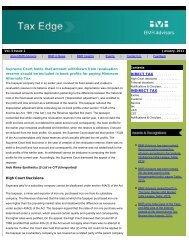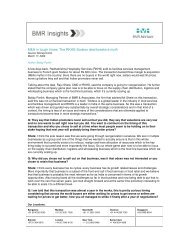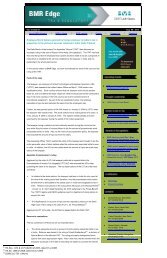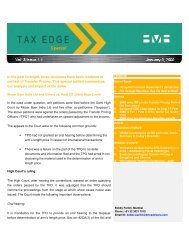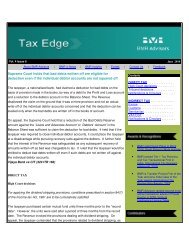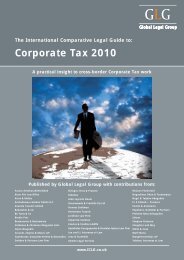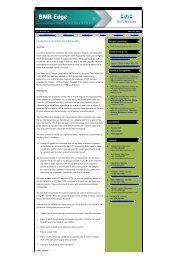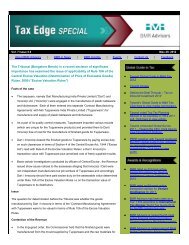BMR Edge-Tax & Regulatory Mont - BMR Advisors
BMR Edge-Tax & Regulatory Mont - BMR Advisors
BMR Edge-Tax & Regulatory Mont - BMR Advisors
Create successful ePaper yourself
Turn your PDF publications into a flip-book with our unique Google optimized e-Paper software.
eautifying, promoting attractiveness etc) which are not present in ‘Dettol’.<br />
Accordingly, ‘Dettol’ being a drug would get covered under the specific entry no 21 of<br />
the Fourth Schedule of the Assam VAT Act taxable at 4 percent during the disputed<br />
period.<br />
Reckitt Benckiser v State of Assam [2012-56-VST-452 (Gau)]<br />
Excise<br />
Section 11AC of the Central Excise Act, 1944 allows a taxpayer the option to pay only<br />
25 percent of the demand as penalty if the entire demand along with interest and<br />
reduced penalty is paid within 30 days from the date of communication of Central<br />
Excise Officer’s order. The said time limit cannot be modified by any authority<br />
whatsoever<br />
The taxpayer, a manufacturer of excisable goods, had availed excess input credit<br />
which was subsequently reversed after it was pointed out by the Revenue Authorities.<br />
Penalty under section 11AC of the Central Excise Act, 1944 was confirmed against<br />
which an appeal was filed before the Customs Excise and Service tax Appellate<br />
Tribunal (“Tribunal”). The Tribunal observed that the adjudication order did not provide<br />
the taxpayer the option to pay reduced penalty of 25 percent under section 11AC and<br />
held that the benefit of reduced penalty would be available if 25 percent penalty is paid<br />
within 30 days of communication of its order. The Revenue Authorities seeking to<br />
recover 100 percent penalty preferred an appeal before the Bombay HC against the<br />
decision of the Tribunal.<br />
The Revenue Authorities contended that once demand was confirmed by invoking<br />
larger period of limitation, penalty under section 11AC was to be compulsorily levied<br />
and the benefit of 25 percent penalty would be available only if the demand along with<br />
interest and reduced penalty is paid within 30 days of the communication of Central<br />
Excise Officer’s order as provided under the Central Excise Act, 1944.<br />
The taxpayer argued that the Tribunal’s order is perfectly valid as the operative part of<br />
the adjudication order did not explicitly clarify the option of reduced penalty available<br />
with the taxpayer.<br />
The Bombay HC disregarded the taxpayer’s arguments by stating that it was not<br />
obligatory to include the above explained option in the adjudication order’s operating<br />
part. The taxpayers’ plea that section 11AC should be read liberally was rejected as<br />
the section imposed punishment on those who evaded taxes. The appeal was allowed<br />
and it was held that when the legislature specifically fixed a time limit to avail an<br />
incentive, it was not open for any authority to modify the time limit so fixed.<br />
CCE v Castrol India Ltd [2012 (286) ELT 194 (Bom)]<br />
Benefits provided under Exemption Notification No 56/2002 – CE will be available even<br />
though the Khasra numbers of the industrial areas where the units are located are<br />
different from those given under the relevant Notification<br />
The taxpayer, located in Jammu & Kashmir, was in the business of manufacture of<br />
goods which were exempt from excise duty as provided under Exemption Notification<br />
No 56/2002 – CE subject to the condition that the goods were manufactured and<br />
cleared by units located in industrial growth centres, industrial estates, export<br />
promotion industrial parks, etc as given under Annexure II to the said Notification.<br />
In the present case, appeals were filed before the Tribunal by the Revenue Authorities<br />
against the decision given by the Commissioner of Central Excise (Appeals) in favour<br />
of the taxpayer on the ground that the units of taxpayers were located in Khasra<br />
numbers other than those specified in the Notification No 56/2002 – CE.<br />
The Revenue Authorities agreed to the fact that the goods and the industrial areas<br />
where the units were located were specified in the Notification but argued that duty<br />
was still payable because the units were not located in Khasra numbers specified<br />
against the corresponding industrial area in the said Annexure. It was further argued<br />
that the provisions of the Notification be construed strictly and interpreted only on their<br />
wordings.<br />
The Tribunal observed that in some cases there were some typo-graphical mistakes<br />
and in other cases the relevant Khasra numbers were included in the Notification albeit<br />
they were wrongly specified against other industrial areas. After noting that the<br />
Notification did not stipulate that the unit must also be located in the Khasra numbers<br />
mentioned against the each industrial area, the Tribunal held that just because of<br />
some typo-graphical mistakes or just because a Khasra number is mentioned against<br />
a wrong industrial area, the benefits of the Notification could not be denied to the<br />
taxpayer. Consequently, all the appeals of the Revenue Authorities were dismissed.<br />
CCE v BR Agrotech Ltd [2012 (286) ELT 127 (Tri – Del)]<br />
The liability to pay excise duty in case of job work arrangements falls on the person<br />
who gets the goods manufactured on job work basis<br />
Diwan Saheb Fashions, the taxpayer, was engaged in stitching garments out of fabric<br />
bought by customers from their shop (stitching to take place after sale of fabric) or from



